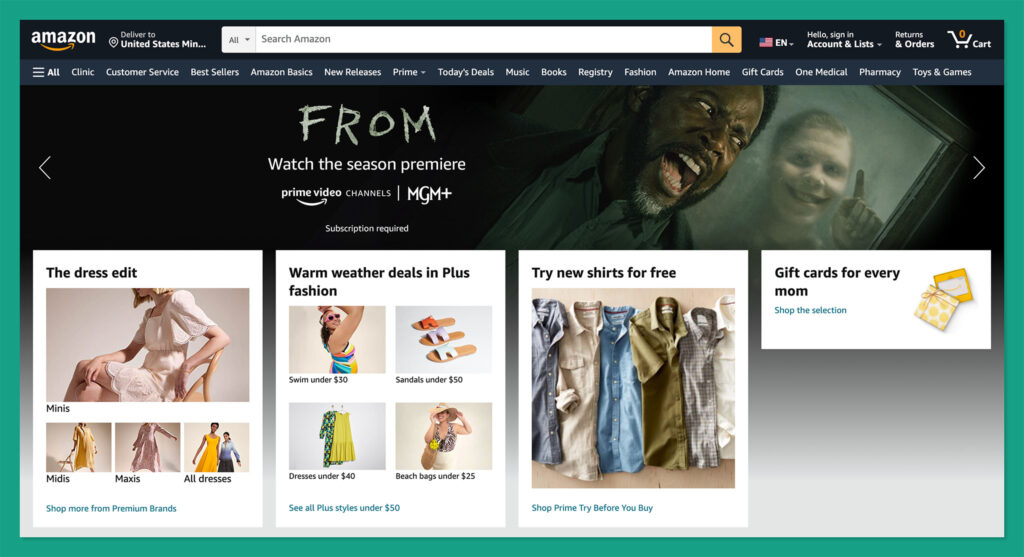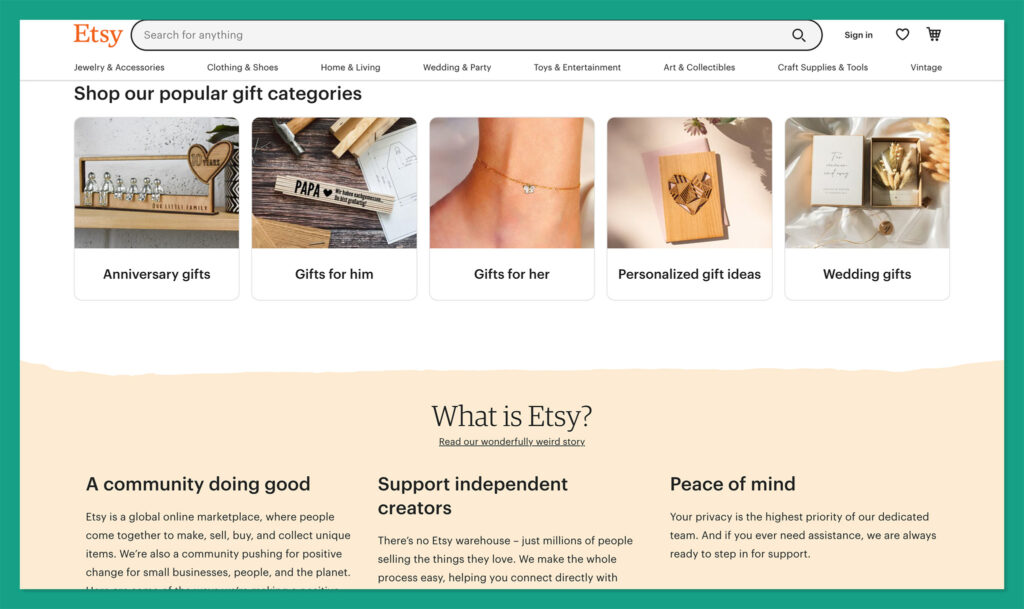Amazon vs Etsy: which marketplace is best for your budding business?
Both Etsy and Amazon offer online retailers an excellent opportunity to connect instantly with an audience of engaged consumers. Selling on either platform can allow you to skip the stress of building your own website and start making a profit almost instantly. Alternatively, you might consider selling on Amazon and Etsy to increase your customer base and revenue, alongside an online store.
However, while Amazon and Etsy have some overlapping features, they deliver different benefits, for different types of sellers. Here’s what you need to know when choosing between Amazon and Etsy.
What is Amazon?

Let’s start with the basics: What is Amazon?
Amazon is one of the world’s biggest online marketplaces, committed to selling goods from virtually every category to customers around the world. With more than 12 million items to choose from, and thousands of merchants, Amazon makes it easy for consumers to find anything they need, and get it delivered to their door, fast.
More than just a marketplace, Amazon forms an important part of the purchasing journey for many consumers, with around 9 out of 10 shoppers comparing prices on the platform. For sellers, Amazon offers an excellent opportunity to immediately connect with potentially millions of customers. You can choose to sell products from a huge range of different product categories, and even link your Amazon marketplace store with an existing ecommerce site built with a tool like Shopify.
Amazon Pros and Cons
Pros 👍
- Suitable for selling products across a variety of categories
- Easy to use environment for sellers and buyers
- Huge global reach with millions of customers
- Support for numerous payment methods
- Access to fulfillment by Amazon FBA
- Fantastic for developing brand awareness
Cons 👎
- Very competitive for retailers
- High fees for sellers
- Limited access to customer information
- Very few options for branding
What is Etsy?

Similar to Amazon, Etsy is an online marketplace, where retailers can list and sell a variety of different items. However, unlike Amazon, Etsy focuses primarily on creative products. This is the platform most consumers use to find handmade, hand-altered, and custom products, as well as vintage and antique items. It’s home to around 7.5 million sellers, and more than 50 million buyers.
Unlike Amazon, Etsy requires each professional seller to belong to the creative economy. If you sell party supplies, handmade items, or specialist personalized products, then you’ll probably do well on Etsy. Etsy is ideal for creative professionals looking to sell arts and crafts, unique materials, and a range of other products from the creative landscape. It’s particularly popular among consumers searching for customized or personalized products for gifts. Plus, Etsy can integrate with a range of online stores, similar to Amazon.
Etsy Pros and Cons
Pros 👍
- Specialist focus on hand-made and creative products
- Fantastic reputation among buyers and sellers
- Relatively affordable fees and pricing
- Excellent ease-of-use for sellers and consumers
- Numerous marketing and sales tools
- Support for a range of payment options
- Tools for building an effective storefront
Cons 👎
- Limited customization options
- Expensive shipping fees
- Lots of competition
- Fewer categories to choose from
Etsy vs Amazon: Fees and Pricing
Although selling on Amazon and Etsy won’t require you to pay the same fees involved in setting up and running a comprehensive online store, there are still costs to consider.
Let’s start by looking at the Etsy fees.
Etsy charges around 20 cents for each listing on the platform. If you create a listing for a product with multiple variations (such as different sizes and colors) it’s still classed as a single listing. There’s also an auto-renew feature on this fee, which means you pay every time your listing expires (after 4 months), to add it back to your storefront. You’ll also be charged for listing multiple quantities of a product whenever you sell your inventory.
Etsy also charges transaction and shipping fees. Transaction fees add up to around 6.5% of the price of the item you sell, in your designated currency. The company also takes a portion of your total shipping charges, so you’ll need to take this into account when calculating costs.
Etsy’s payment processing fees vary depending on which country you’re in, and there are currency conversion fees you’ll need to consider if you’re selling to customers worldwide. On top of all that, Etsy also charges fees for advertising (offsite and on-site ads), the Pattern service ($15 per month), and Etsy Plus ($10 per month in subscription fees) if you want to access extra features.
Amazon’s fees are also variable depending on the kind of business you want to run. First, you’ll need to choose between either an Individual selling plan at $0.99 per month, per unit sold, or the Professional plan $39.99 per month. The Professional selling plan allows you to sell unlimited products, with no extra monthly subscription costs.
Amazon also charges a referral fee of between 8 and 15% for each item you sell. Plus, you can pay extra for access to services like FBA (Fulfillment by Amazon), as well as long-term storage, advertising, and premium account services.
While Amazon’s fees are a little more expensive overall than those on Etsy, the company does offer a range of incentives to help beginners get started on the platform. You can learn more about the various Amazon fees you might encounter here. Additionally, with Amazon, you’ll be able to access much faster fulfillment in exchange for your shipping costs.
Etsy vs Amazon: Ease of Use
As mentioned above, one of the things that makes both Amazon and Etsy so appealing to sellers and buyers, is how easy they are to use. Both platforms come with virtually all of the solutions you might need to get your own store up and running. The sign up process for both marketplaces is extremely straightforward, although you may need to share a few more details with Amazon.
With Etsy, all you need to do to create a storefront is create an account using your email, Google, or Facebook details. The storefront environment will allow you to set up and edit your listings, navigate through your store, and track your inventory. There are Quick Edit modes to help you update everything in a couple of clicks. Plus, you can leverage shipping partnerships with Canada Post, USPS, and FedEx, all within your dashboard.
Etsy has its own Shipping Label services to help you prepare an item for sale. Plus, you can integrate your store with external fulfillment and logistics services too.
Amazon is also a relatively straightforward solution for both buyers and sellers. You can create an account in almost no time, and start adding products to your store with the help of step-by-step guides and FAQs. If you need help with fulfillment, the FBA service is on-hand to ensure you can get items to customers in some parts of the world within as little as a single day.
You can import products to your Amazon storefront using Excel files, and tack everything from inventory to returns in your backend environment. The “Seller Central” solution gives you access to a range of templates for your online store, as well as step-by-step advice on getting started. Amazon will also help you to build better relationships with customers by handling returns and refunds.
Etsy vs Amazon: Marketing and Ads
Compared to building and promoting your own online stores using solutions like Wix and Shopify, Etsy and Amazon won’t give you quite as many options for marketing. However, there are ways you can boost your chances of being seen on either marketplace.
Etsy offers access to both off-site and on-site ads. An onsite ad allows you to promote your product listings at the top of the search page when customers look for specific keywords. It’s a bit like using Google’s PPC ads. If you choose the off-site function, you can promote items to customers on a range of channels across the internet.
The great thing about off-site ads from Etsy is you only pay a fee when you sell something. The fee is charged on a yearly basis. If you make more than $10,000, you’ll pay around 15% of your revenue to Etsy, while you only pay 12% if you make less.
Amazon allows you to create and manage ads using the Seller Central environment. You can take advantage of marketing solutions similar to Google, with PPC campaigns and even SEO. Like with Etsy, if you choose to promote external ads from Amazon, you’ll pay every time a shopper clicks on one of your ads.
Both tools will allow you to track the metrics from your advertising campaigns in your back-end dashboard, so you can learn more about which strategies are working best for your company. However, Amazon does give you a few more advanced options for promotion, like display and video ads you can showcase throughout the Amazon landscape.
Etsy vs Amazon: Customer Support
While both Etsy and Amazon make it relatively easy to start selling products as an ecommerce brand, there’s a chance you will eventually need a little support. Fortunately, both Amazon sellers and Etsy sellers can expect to get brilliant guidance from either platform.
Entrepreneurs on Etsy can find dozens of articles and blogs on the website on how to make a profit from handmade goods and vintage items. Plus, if you run into any technical issues, you’ll be able to contact the Etsy team through your seller account. Etsy supports email, live chat, and phone service, so you can generally get a response to all of your questions pretty quickly.
Similar to Etsy, Amazon has its own excellent help center, where you can learn all about growing your ecommerce business. There are blogs and guides on using Amazon FBA, managing your selling fees, and taking advantage of Amazon Prime.
If you need help with something you can’t find an answer to on the Amazon help center, you’ll be able to get in touch with the team through live chat, email, or phone, using the customer service menu on the Amazon website (through your seller account).
Amazon vs Etsy: Verdict
Ultimately, both Amazon and Etsy are excellent marketplaces for any small business looking for ways to connect with a wide audience and increase sales. Both solutions are extremely user-friendly, and can integrate with other online shop tools, social media channels, and various fulfillment apps. Plus, they make it easy to find potential customers, as millions of people shop on both channels each day.
However, there are some significant differences between Amazon and Etsy worth keeping in mind before you launch your online shop.
For instance, Amazon gives business owners a much wider range of product categories to choose from. Active sellers can list just about anything on the platform, from technology, to print-on-demand garments. Additionally, Amazon offers access to a great fulfillment service, which can deliver products to customers within as little as one day.
Alternatively, Etsy focuses primarily on vintage goods and handcrafted and handmade products. You’re most likely to benefit from creating an Etsy store if you’re a creative professional with a host of DIY skills. If you’re selling craft supplies, or custom products, Etsy will make it easy to connect with your audience. Plus, you don’t have to pay a monthly fee to get started, unless you want to use the Pattern service or Plus plan for your Etsy shop.
The choice of which platform to use will depend on your business model. However, it’s worth keeping in mind there are ecommerce platforms out there that allow entrepreneurs and handmade sellers to use a range of channels at once, such as Ebay, Amazon, and Etsy, like Shopify.




Comments 0 Responses